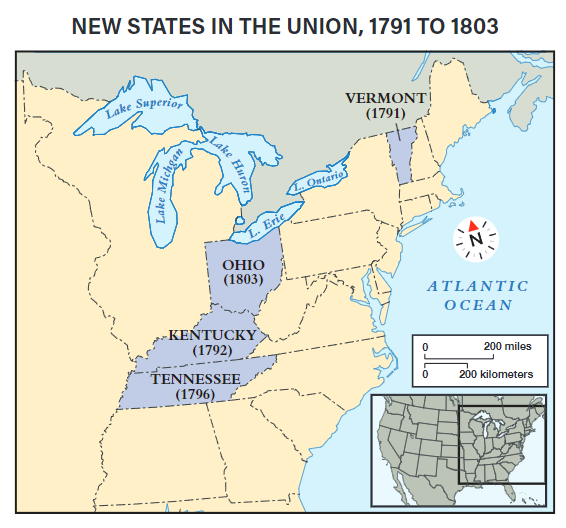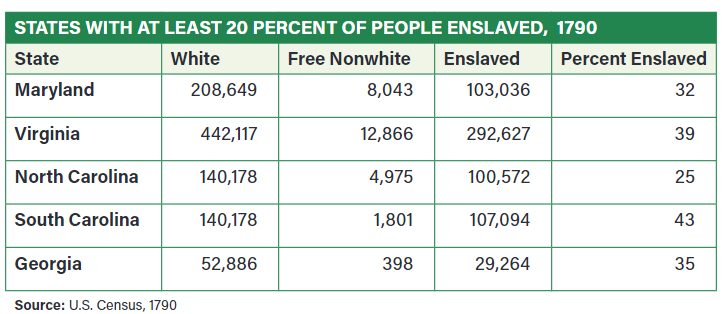3.12 Movement in the Early Republic
LEARNING OBJECTIVE 1: Explain how and why migration and immigration to and within North America caused competition and conflict over time.
LEARNING OBJECTIVE 2: Explain the continuities and changes in regional attitudes about slavery as it expanded from 1754 to 1800.
INTRODUCTION
Founding of republic increased movement of people (mainly westward)
Uncertanties of rebellion and war had ended
- Peace and removal of British control—→
- Re-ordering of government and life
Hostile forces remained on boards of new nation
- Brtish north and west, Spanish south and west
- Both threatened young country’s existence
- Within borders were Natives (resented expansion of European settlement on their lands)
MIGRATION AND SETTLEMENT
Westward movement faced a range of forces (both friendly and hostile)
Movement was recognized and accepted from the very beginning of the nation
Northwest Ordinance (under the AOC)
- provided mechanism for migration and settlement.
- planned for the sale of government land
- orderly adoption of western territory into new states
- public education
- outlawed slavery in this territory
Government forseen migration, but couldn’t stop disputes and conflicts that developed
AMERICAN INDIANS
Natives found themselves losing conflicts with settlers—→
Native increasingly living on reservations or being forced to migrate
LAWS
Indian intercourse acts was one of the 1st laws passed by new nation
Act placed federal gov in control of all legal actions with Natives
- only federal gov (not states) could purchase native land and regulate trade over their lands
- laws were largely ignored by traders and settler migrating westward
RESISTENCE
Gov usually supported settlers when disputes w Natives turned violent (despite settlers ignoring laws to maintain peace)
In northwest territory, confederation of Shawnee and other American Indians sucessfully defeated gov troops—→
- larger gov force defeated confederation at Battle of Fallen Timbers
American Indian position was further weakened as British (who supported natives) closed trading forts following American revolution.
WEST OF THE MISSISSIPI
Migration was a survivable option for many tribes
Natives faced overwhelming force, foreign disease, destruction of their hunting grounds (deprived food and trade).
Some remained where their ancestors had settled
- unwilling to leave their traditional lands despite being surrounded by hostile settlers
Others migrated
- Iroquois stayed on reservations or moved north
- Shawnee and Cherokees moved acorss the mississipi river
Journeys were dangerious as tribes resisted theres incursions into their tradional land
THE SOUTHERN FRONTIER
Further south, the Spanish were concerned with stopping settlers from US—→
Allowed Natives more freedom

POPULATION CHANGE
Population increased for several reasons
Europeans continued to immigrate to the US
- came in small numbers (flow depended on reaction to political or economic upheavels in Europe)
Enslaved africans continued to be imported
- slaveowners recognized that trade would go on til 1808
Largest population gain was natural
- births exceeded deaths (plentiful food supply and desire for children who could help on farms)
The westward movement was aided by scouts and early settlers
Blazed trails through the wilderness for others to follow
- Daniel Boone led the way across the Appalachian Mountain and establish early white settlement in northwest
SLAVERY
People began to openly oppose slavery by late 18th century
Many were quakers, mennonites, and other people of Christian faith
- some were influenced by enlightenment ideals (liberty and equality)
- saw no place for slavery in democratic republic
- many people disliked slavery (hoped it would fade away like in Europe and Latin America)
- believed increasing immigration would provide low-cost labor to replace enslaved labor.
COTTON
Slavery grew rather than declined
Eli Whitney invented cotton gin
- device for separating cotton fiber from seeds
- heightened efficiency of cultivating cotton (growing cotton became immensely profitable)—→
- higher demand for slaves
Mechanization of textile industry also increased value of cotton
- British were first to mechanize (passed laws against taking knowledge of factories outside the country)
- Samuel slater memorized British factory design and built his own factory in US—→ more efficient textile industry in US
Combination of cotton gin and development of textile industry made cotton cloth less expensive and more plentiful
- cotton became potent global industry
CONFLICT OVER EXPANSION OF SLAVERY
US plantation owners were eager to increase cotton production with slave labor
Looked westward for more land
- Quickly settled in Alabama and Mississippi (good climate and geography for growing cotton)
- Their desire for lands west and north would soon face resistance (northerns opposed slavery/wanted to settle in these lands themselves w/o competition from enslaved workers)—→
- regional conflict over slavery arose
THE MOVEMENTS OF ENSLAVED AFRICANS
Some enslaved people were able to escape bondage
Found liberty by reaching free states in the north
- constitutuion included the clause that required states to return fugitives to their owners
- some went to Canada, Florida, or lands controlled by Natives
Most enslaved people moved because of their owners’ search for greater profit
- Chesapeake planters had more slaves than they wanted
Decline in uncertian tobacco markets, natural growing slave population, and expanded importation—→ increase of slaves
- Efforts to train enslaved people in skilled trades or lease them as servants did not meet financial desires
- Moving enslaved people from fields to towns added to risk of people escaping to freedom in the north
Growing demand for workers in cotton fields provided Chesapeake planters with new opportunity
They could sell their slaves to cotton planters in newly settled lands (Alabama and Mississippi)
- interregional slave trade became very large (500,000-1 mil slaves were transported before the civil war)
- trade often broke families apart (many slaves never saw their parents, children, or other relatives again)
